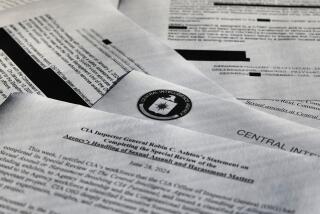Ames Case Prompts Key CIA Meetings : Espionage: Director Woolsey meets with top staff before deciding on possible discipline for those who failed to stop the Soviet spy.
- Share via
WASHINGTON — CIA Director R. James Woolsey has been meeting with his top staff for the past three days to decide what to do about the counterintelligence failures that allowed Soviet spy Aldrich H. Ames to operate for nine years, according to CIA sources.
The scope and depth of those failures were outlined in a classified 400-page report by CIA Inspector General Frederick P. Hitz after an eight-month inquiry.
The report showed that Ames, a veteran agency counterintelligence officer, gave information that enabled Moscow to identify up to 34 U.S.--or allied--paid Russian agents, and exposed 55 clandestine operations. At one point, according to the report, Ames’ disclosures, beginning in 1985, virtually closed down intelligence operations involving Russian agents.
Hugh E. (Ted) Price, the deputy director for operations and the CIA’s third-ranking official, is not participating in Woolsey’s sessions because he is one of several veteran, high-ranking officers who face possible censure because of their roles in the Ames case, according to sources inside and outside the agency.
In 1988-89, when the agency’s internal hunt for a possible Soviet mole was all but halted, Price was deputy director and then director of the CIA counterintelligence center that had prime responsibility for the internal investigation.
Present and former senior officials from the CIA security office, whose early investigations into Ames’ excessive spending bogged down in bureaucratic infighting, were sharply criticized in the report and also face disciplinary action.
Agency officials, including Woolsey, are sensitive to the impact any personnel actions could have on the already low morale at the agency, where budget cuts, concern about the post-Cold War mission, the Ames case and charges of racial and sexual harassment have contributed to an atmosphere of tension and uncertainty.
The inspector general’s report accepts statements by Ames that he began spying in early 1985 because he was divorced, wanted to remarry and needed money. Over the next nine years, he received more than $2 million and had been promised another $1 million or more by the new Russian government before his arrest in February. In April, Ames pleaded guilty to espionage and tax charges and was sentenced to life in prison.
More to Read
Sign up for Essential California
The most important California stories and recommendations in your inbox every morning.
You may occasionally receive promotional content from the Los Angeles Times.












